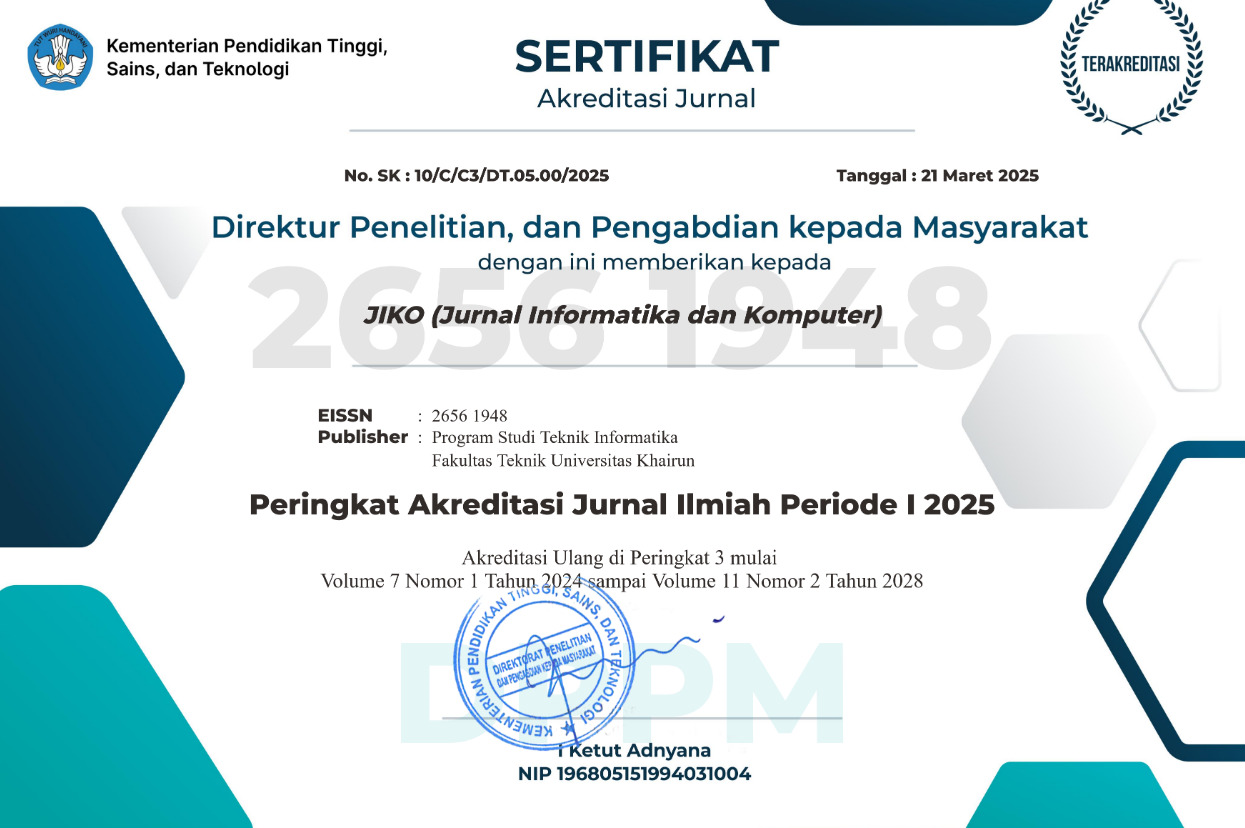IMPLEMENTATION OF INFORMATION GAIN AND PARTICLE SWARM OPTIMIZATION UPON COVID-19 HANDLING SENTIMENT ANALYSIS BY USING K-NEAREST NEIGHBOR
Abstract
In early 2020, a new virus from Wuhan, China, identified as the coronavirus or COVID-19, shocked the entire world. (Coronavirus Disease 2019). The government has made various attempts to combat this outbreak, despite the fact that the government's involvement in combating Covid-19 has many benefits and disadvantages. One of the most commonly debated subjects on Twitter is the Indonesian government's response to the Covid-19 virus. This research compares the k-nearest neighbor classification technique, Information Gain feature selection with the K-Nearest Neighbor classification algorithm, and Information Gain feature selection and Particle Swarm Optimization optimization with the K-Nearest Neighbor classification algorithm. Comparisons are performed to determine which method is more accurate. Because it is frequently used for text and data categorization, the K-Nearest Neighbor algorithm was selected. The K-Nearest Neighbor algorithm has flaws, including the ability to be fooled by irrelevant characteristics and being less than ideal in finding the value of k. The selection of the Information Gain feature could indeed solve this issue by decreasing Terms that are less important and to optimize the K-Nearest Neighbor categorization, an optimization method with the Particle Swarm Optimization algorithm is employed to maximize the K-Nearest Neighbor classification. According to the results of this research, the K-Nearest Neighbor categorization with Information Gain feature selection and Particle Swarm Optimization optimization is better than the K-Nearest Neighbor model without selecting features and without optimization and is better than the K-Nearest Neighbor model with Information Gain selecting features, notably 87,33% with a value of K 5.
Full Text:
PDFReferences
Syarifuddinn, M., 2020. Analisis Sentimen Opini Publik Mengenai Covid-19 Pada Twitter Menggunakan Metode Naïve Bayes Dan Knn. Inti Nusa Mandiri, 15(1), pp.23-28.
Hidayah, N. and Sahibu, S., 2021. Algoritma Multinomial Naïve Bayes Untuk Klasifikasi Sentimen Pemerintah Terhadap Penanganan Covid-19 Menggunakan Data Twitter. Jurnal RESTI (Rekayasa Sistem dan Teknologi Informasi), 5(4), pp.820-826.
Irawan, F.R., Jazuli, A. and Khotimah, T., 2022. Analisis Sentimen Terhadap Pengguna Gojek Menggunakan Metode K-Nearest Neighbors. JIKO (Jurnal Informatika dan Komputer), 5(1), pp.62-68.
Lestari, D.A. and Mahdiana, D., 2021. Penerapan Algoritma K-Nearest Neighbor pada Twitter untuk Analisis Sentimen Masyarakat Terhadap Larangan Mudik 2021. Informatik: Jurnal Ilmu Komputer, 17(2), pp.123-131.
Desiani, A., 2022. Perbandingan Implementasi Algoritma Naïve Bayes dan K-Nearest Neighbor Pada Klasifikasi Penyakit Hati. Jurnal Sistem Informasi dan Sistem Komputer, 7(2), pp.104-110.
Isnanda, A., Umaidah, Y. and Jaman, J.H., 2021. Implementasi Naïve Bayes Classifier Dan Information Gain Pada Analisis Sentimen Penggunaan E-Wallet Saat Pandemi. Jurnal Teknologi Informatika dan Komputer, 7(2), pp.144-153.
Aini, S.H.A., 2018. Seleksi Fitur Information Gain untuk Klasifikasi Penyakit Jantung Menggunakan Kombinasi Metode K-Nearest Neighbor dan Naïve Bayes (Doctoral dissertation, Universitas Brawijaya).
Que, V.K.S., Iriani, A. and Purnomo, H.D., 2020. Analisis Sentimen Transportasi Online Menggunakan Support Vector Machine Berbasis Particle Swarm Optimization. Jurnal Nasional Teknik Elektro dan Teknologi Informasi| Vol, 9(2).
Mahardika, K.W., 2018. Optimasi K-Nearest Neighbour Menggunakan Particle Swarm Optimization pada Sistem Pakar untuk Monitoring Pengendalian Hama pada Tanaman Jeruk (Doctoral dissertation, Universitas Brawijaya).
Putri, F.O. and Indriati, R.C.W., Analisis Sentimen pada Ulasan Pengguna MRT Jakarta Menggunakan Metode Neighbor-Weighted K-Nearest Neighbor dengan Seleksi Fitur Information Gain. Jurnal Pengembangan Teknologi Informasi dan Ilmu Komputer e-ISSN, 2548, p.964X.
Utomo, P.E.P., Manaar, M., Khaira, U. and Suratno, T., 2019. Analisis Sentimen Online Review Pengguna Bukalapak Menggunakan Metode Algoritma TF-IDF. JUSS (Jurnal Sains dan Sistem Informasi), 2(2), pp.35-39.
Al Faraby, S., 2021. Analisis Sentimen Pada Ulasan Produk Kecantikan Menggunakan K-nearest Neighbor Dan Information Gain. eProceedings of Engineering, 8(5).
Rahman, A.F. and Indriati, M., Analisis Sentimen Penggunaan Tol Trans Jawa Periode Mudik Lebaran 2019 dengan Metode K-Nearest Neighbor dan Seleksi Fitur Information Gain. Jurnal Pengembangan Teknologi Informasi dan Ilmu Komputer e-ISSN, 2548, p.964X.
Nuris, N., Yulia, E.R. and Solecha, K., 2021. Implementasi Particle Swarm Optimization (PSO) Pada Analysis Sentiment Review Aplikasi Halodoc Menggunakan Algoritma Naïve Bayes. Jurnal Teknologi Informasi, 7(1), pp.17-23.
Akbar, F.R., 2020. Implementasi Analisis Data Kredit Nasabah Menggunakan Metode K-Nearest Neighbors (Doctoral dissertation, Institut Teknologi Nasional Malang).
DOI: https://doi.org/10.33387/jiko.v6i1.5260
Refbacks
- There are currently no refbacks.











